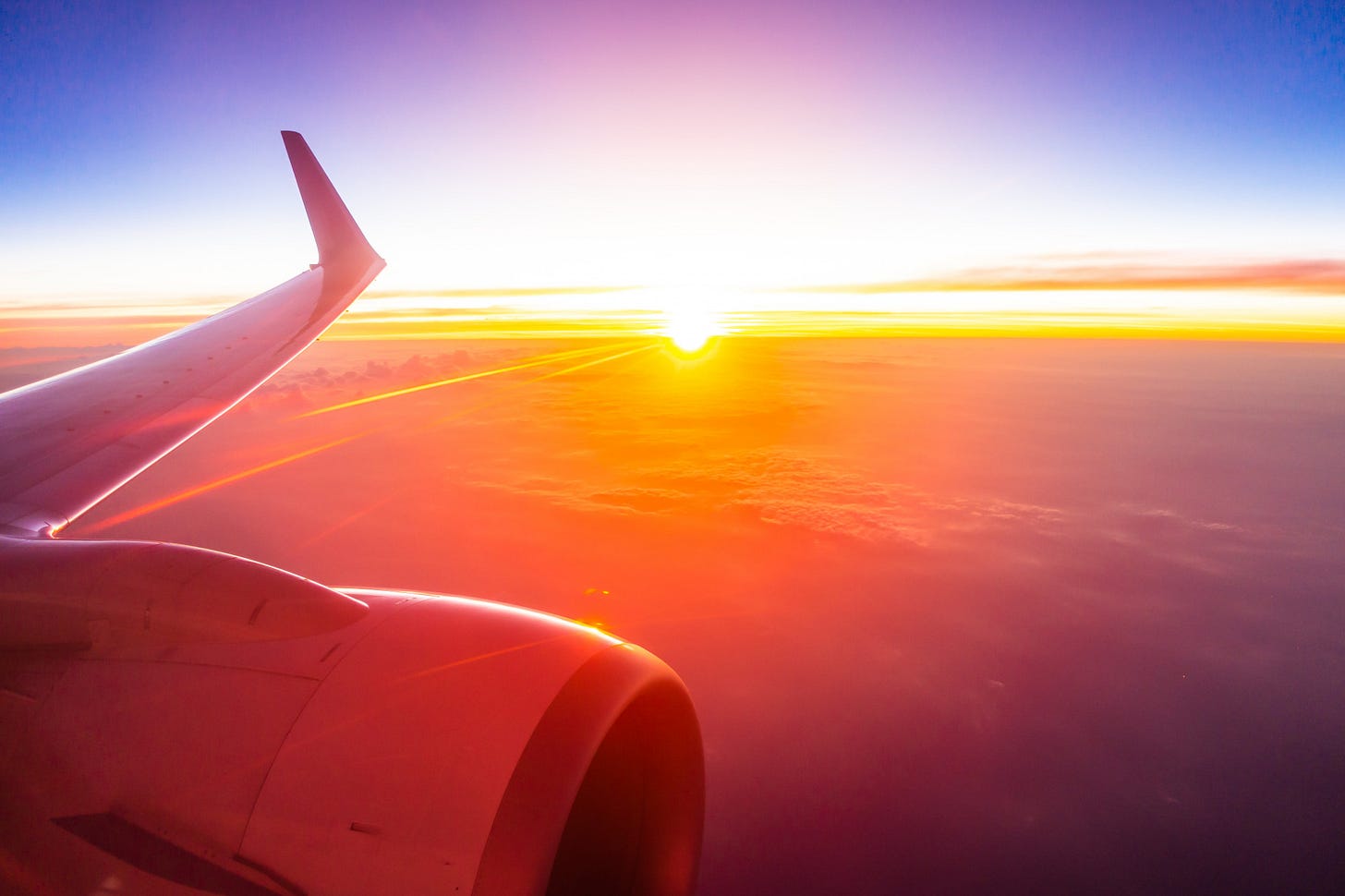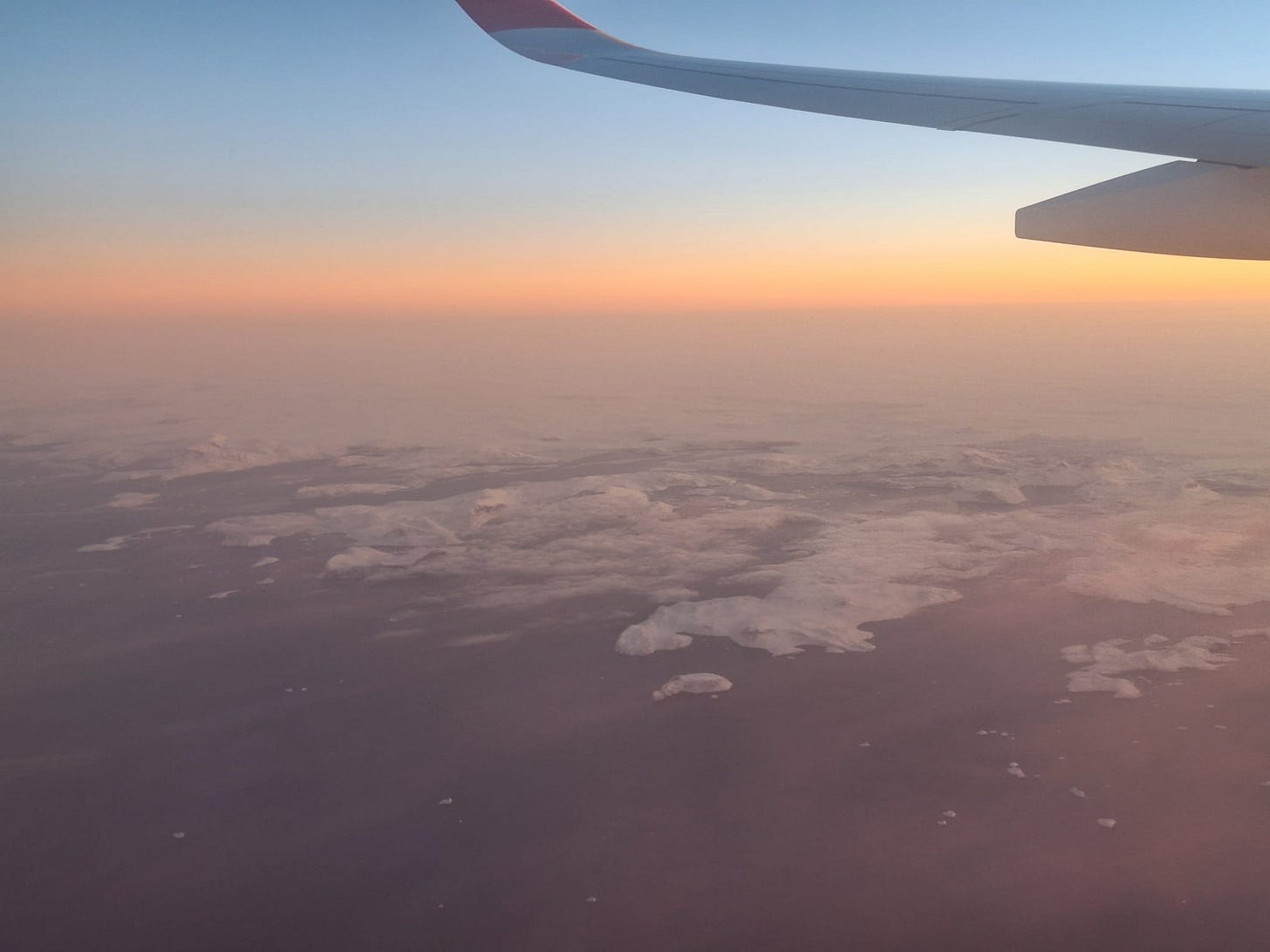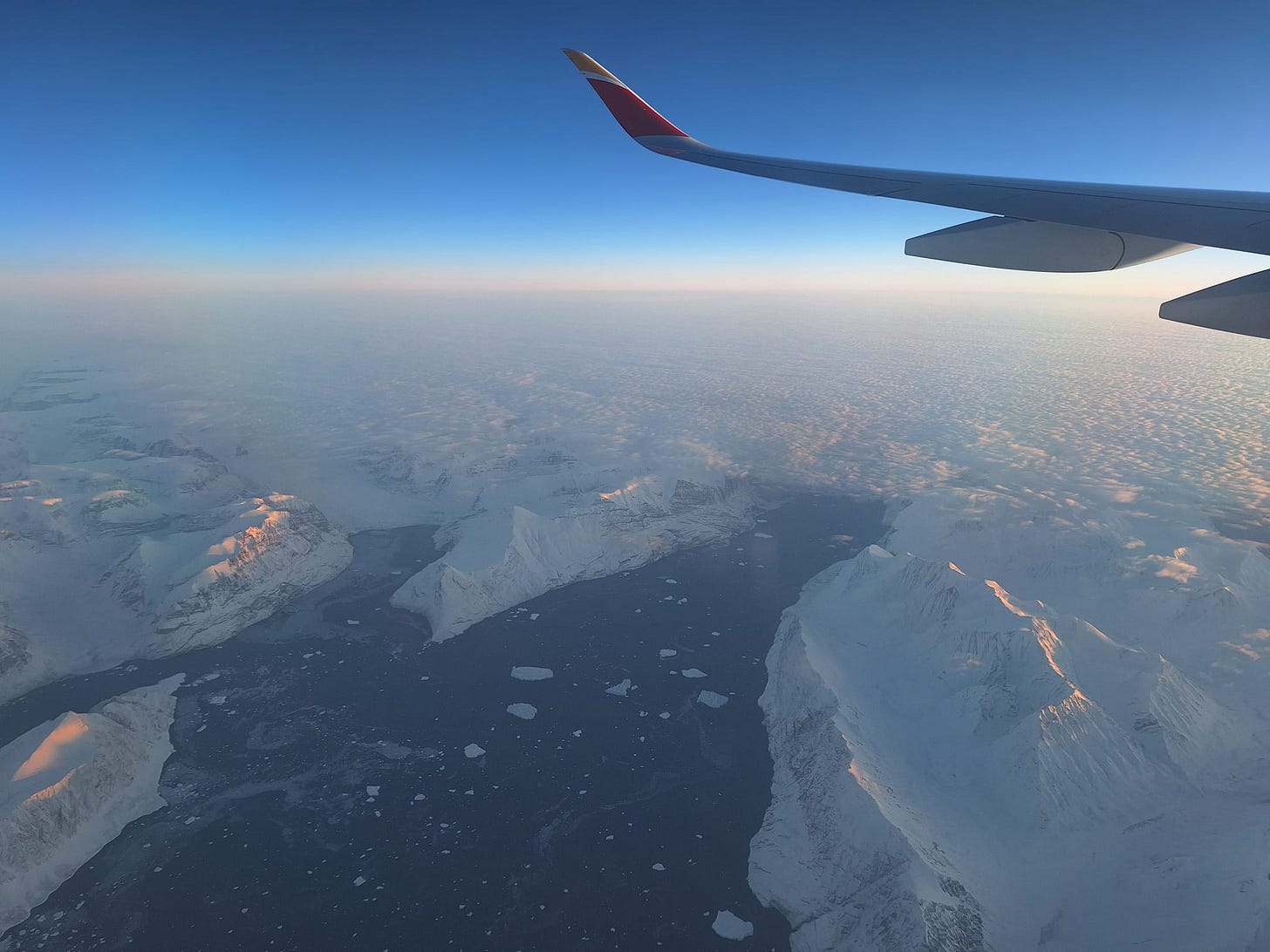Two sunrises and two sunsets in a single day
Northern lights, two sunsets in one day, and a unique view of Greenland. In short, the advantages of travelling from Tokyo to Madrid without being able to fly over Russia.
The first time I travelled to Tokyo was in 2012. A good friend had just moved to Japan and, with the excuse of visiting her, I took the opportunity to do some sightseeing and get to know the country. Japan is a destination I recommend to everyone, even if it’s only once in a lifetime. Its cuisine is impressive1, its cultural heritage is fascinating, and its art is quite different from what we are used to in Europe.
On that first occasion, the flight crossed the northern parts of Russia. This route is counterintuitive if we think about it on a traditional map, although it is perfectly reasonable if we understand the importance of geodesic lines, as I explained here some time ago.
Times have changed, and that trip is no longer possible. Following Russia’s invasion of Ukraine, which began on 24 February 2022, the European Union banned Russian aircraft from flying over its airspace2. In response, on 28 March, Russia applied the same restriction to European airlines, meaning that journeys from Europe to Japan could no longer take the shortest route.
Two weeks ago, on 16 October, I travelled to Tokyo again, so I was able to experience the implications of the air restrictions first-hand. The outbound journey had to avoid Russia completely, so you can see how the pilot opted for more southerly latitudes, flying over the Caucasus, Kazakhstan and China, until reaching Japan.

But what was astounding was the return journey: Iberia’s route was eastwards, flying over Alaska, northern Canada and Greenland. This was the path followed by the flight, as shown on the screens of my Iberia flight3 last Monday, 27 October.
The mere idea of this route had raised certain expectations in me, but ultimately, it turned out to be more interesting than I had expected. Almost enough to make up for the 15-hour flight, which was a real pain4.
Two sunrises and two sunsets
Last Monday, 27 October, was a unique day for me. I saw the sunrise in Koganei, a city in western Tokyo, at around 6 a.m. The Greater Tokyo Area has possibly one of the best urban transport networks in the world, but Tokyo is still huge, so I had to plan for more than two and a half hours to get to Narita Airport.
The plane took off at 11:45 a.m., and just three or four hours later, before reaching the Bering Strait, night fell. I hadn’t looked into it in detail, but I assumed that since we were arriving in Madrid at around 8 p.m. local time5, the rest of the journey would be spent in the dark.
But then, as we left Ellesmere Island, north of Canada, the second sunrise of the day took place.

I must admit that seeing two sunrises in a single day was not part of my plans. In fact, I hadn’t considered it was even possible; however, it appears that it is. When travelling east, taking off at the right time and flying long enough above the Arctic Circle, it can be achieved.
This second day lasted about seven hours, as half an hour before landing in Madrid, the sun set for the second time that day.
Northern lights
The first time I saw northern lights was ten years ago in Iceland, and I could only enjoy them for a few minutes. I’ve had it in the back of my head for ten years and, somehow, I was hoping to get rid of it during this trip. It was the first time I was going to fly close to the North Pole, and at night, which greatly increased the chances of seeing the northern lights.
A few days earlier, I checked what the K geomagnetic index would be on the day of the flight and, unfortunately, the forecast was between 2 and 3, which translates into minimal geomagnetic activity and little chance of seeing the northern lights. The advantage of travelling by plane is that you usually fly above the clouds, so even if there was little activity, there were still chances of seeing something.
That said, once we crossed Alaska, we could see something like this through the plane window.

I tried to take some photographs, but it was completely impossible with the light inside the aeroplane cabin and the low intensity of the auroras. Even so, I was able to see some faint auroras for a few minutes, with a colour very close to white, rising slightly above the horizon.
This will stay in the back of my head, as I would like to see an intense aurora borealis at some point in my life, but something is better than nothing.
Greenland, a world of ice
After the disappointment of the northern lights and the surprise of the second sunrise, what was possibly the most interesting part of the whole trip took place. Reaching the coast of Greenland with the sun low and not many clouds allowed me to enjoy a view that was not in my plans: the ice off the coast of Greenland.
I did take several photos of this. They are not of superb quality, but I think they reflect what can be seen from more than 10 kilometres above sea level when flying over the coast of Greenland: icebergs, fjords and plenty of ice.
Once we were crossing Greenland, the clouds completely covered the ice, and we did not see land again until we entered the Iberian Peninsula. Greenland and Svalbard are not destinations that were high on my travel list, as I feel there is little to do and the experience depends a lot on the weather. But seeing all that landscape from the clouds has made me more curious.
I don’t know if I’ll ever have the chance to do it, but I’ll definitely make a note of it.
After the second sunset and landing, I managed to get home and return to reality. I managed to sleep quite well, but jet lag did its best to make me wake up excessively early for five consecutive days. It seems that this morning everything is back to normal.
It goes far beyond sushi, ramen, mochi or gyoza; Japanese cuisine has preparations and ingredients that can only be fully enjoyed if you visit the country.
The measure was approved on 27 February 2022, a ban that was also imposed by Canada, the United Kingdom and the United States.
I was also going to include the route according to Flight Aware, but the Mercator projection does not do it justice.
In the literal sense. Neither my bum nor my back are ready for it, but hey, I survived.
The time difference between Tokyo and Madrid is 8 hours in winter and 7 hours in summer. In Japan, daylight saving time was only introduced for a brief period between 1949 and 1952. Since then, there have been proposals to reinstate it, but nothing concrete.









